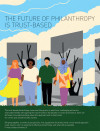 (Illustration by Andrea Mongia)
(Illustration by Andrea Mongia)
On her sabbatical from work, Debra Suh watched her kids and husband play in the Hawaiian waves while her parents relaxed with their books on the shore. Her father, a survivor of domestic abuse, had inspired her work in the domestic-violence-prevention field. Debra’s beach memories became more poignant when her father died the following year.
The Future of Philanthropy Is Trust-Based

The trust-based philanthropy movement has grown in rapid time, but there are still basic misunderstandings about this approach and its bold vision for a more just and democratic society. This supplement illustrates what a trust-based approach really means, why it is essential to effective philanthropy, and what will be possible if more funders embrace it. Sponsored by the Trust-Based Philanthropy Project
In addition to being a parent, partner, and daughter, Suh was the CEO of the Center for the Pacific Asian Family (CPAF), an organization dedicated to ending domestic and sexual violence in Asian Pacific Islander communities. She loved her work and team but was exhausted by her efforts to do as much as possible for both CPAF and her two young children. In 2007, Suh received a three-month sabbatical grant from the Durfee Foundation, which invests in leaders making community change throughout Los Angeles.
The sabbatical marked a turning point for both Suh and CPAF. Before leaving, she restructured it, putting in place a skilled team to manage during her absence. She also delegated more, even after returning from sabbatical. Suh’s senior team handled day-to-day operations, allowing her to focus on more generative leadership. When she returned, she achieved greater balance between her roles as CEO and parent. She remained in leadership for years, growing CPAF’s reach and budget from $1.6 million to more than $5 million. She instituted a sabbatical policy for all staff.
When Suh transitioned out of her leadership role at CPAF after 23 years, the change was smooth. While she was on sabbatical, the staff member who would eventually succeed her many years later as CEO was on the team, burnishing her leadership skills.
Philanthropy’s Role in Supporting Rest
Our belief as foundation leaders is that rest is critical to the work of nonprofits and movements. We have gained many insights in our work supporting sabbaticals and other forms of renewal. Our peer funders—some of whom are leading thoughtful approaches that recognize and fund the essential role of rest and joy in social change—have also provided inspiration.
Rest is transformative. Stories like Suh’s reverberate not only for individuals taking a sabbatical, but also for their organizations and the wider community. Research shows that when nonprofit leaders disconnect from their work for three months, they return with renewed purpose, extend their tenure, and discover new sources of energy and inspiration.
Individual rest is important for more than simply avoiding burnout. There are sector-wide implications for how we see collective care. According to the Clare Rose Foundation’s 2020 report on nonprofit sabbatical programs, only one in four nonprofits have a leadership-succession plan in place, and two-thirds of leaders plan to leave their positions within two to five years. Funders have not invested in nonprofit retention—and it shows.
Nonprofit Sabbaticals
There is an admonition floating around: “Work smarter, not harder.” But what if the smartest approach is to stop working and truly rest? It may seem counterintuitive, but the Durfee Foundation has adopted this approach since 1997, when it launched its sabbatical program.
Durfee’s sabbatical “formula” is simple: provide a coach to help participants think through their plans, offer wisdom from previous Durfee sabbatical awardees, and prohibit all contact with work and work-related activities. Because sabbatical and renewal grants can be interpreted as grants to individuals, Durfee applied to the IRS for approval to make grants to individuals.
When Durfee introduced the program, the response from the funder community ranged from bemusement to concern. Some saw the funding as frivolous. Others wondered what would happen if overworked nonprofit leaders got a taste of freedom and quit. But our question was different: What if nonprofit staff continue to do their jobs without getting the rest they need?
After 27 years and more than 120 sabbatical awards, Durfee can say with certainty that sabbaticals are remarkably effective tools for change. Rest and joy are not the enemies of productivity, but its source. After Suh’s sabbatical, CPAF’s expanding programs, strength, and budget were not a fluke. At Durfee, we have seen how dozens of organizations across Los Angeles have followed a similar path after their leader took a sabbatical.
Sabbaticals plant seeds that flower. Like Suh, other Durfee sabbatical recipients have gone on to implement organization-wide programs. The Children’s Law Center, with more than 500 employees, recently established a one-month wellness leave for longtime staff.
A three-month CEO sabbatical is not the only option to address the need for rest and rejuvenation in the sector. Alongside its sabbatical program, Durfee offers Lark Awards, providing $30,000 grants to smaller community organizations to support the well-being of all staff. Each recipient can determine how to use funds based on its culture and needs.
Expanding Nonprofits’ Capacity to Rest
In recent years, the Satterberg Foundation has listened closely to grantee partners to learn how to best support their capacity toward building a more just society and more sustainable environment. A theme quickly emerged during its listening tour: staff exhaustion and looming burnout. Many staff described the emotional and physical toll they experienced from work. Some planned to quit, while others desired to leave the nonprofit sector altogether. Such decisions can unleash a domino effect: Leadership transitions reduce staff capacity, diminishing institutional knowledge and leading to fundraising challenges.
Grantee partners emphasized that the most effective role for the foundation was to fund community and nonprofit organizations, allowing them to create their own sabbatical programs and awards, and advocate for other funders to make similar investments.
In response, Satterberg began funding grantee partners to increase opportunities for rest, joy, and renewal in their work. In Washington state, Satterberg provided seed funding and multiyear support to establish the Black, Indigenous, and People of Color Executive Director (BIPOC ED) Coalition’s sabbatical program. The coalition responded to the community’s need for flexibility, creating a menu of options, including breaking the traditional three-month sabbatical into shorter respites of three to five days. The coalition also hosts wellness retreats across the state, making it possible for leaders to find rest and renewal without the burden of planning transportation, covering expenses, and securing extended childcare or eldercare.
Who Gets to Rest?
While leadership happens in all positions, at all ages, and with all voices, most of the sabbatical programs we have researched target executive directors or CEOs of organizations. These leaders have responsibilities that are often unrelenting and isolating, but they are hardly the only staff members who deserve to rest.
Yet there is an undeniable trickle-up effect of this approach. Organizational leaders model work culture. When a leader practices self-care, takes breaks, and trusts staff in their absence, the example is healthy work-life balance. When a leader is available 24/7 and never takes vacation, the message is self-sacrifice. A nonprofit executive director who takes a sabbatical can influence the entire organization for the better.
The question of who gets to rest is of course shaped by power disparities along the lines of race, gender, and class. The BIPOC ED Coalition was created to provide relief from the particular challenges that racially marginalized nonprofit executive directors face. As the coalition’s 2022 Sabbaticals for BIPOC Leaders report explains, BIPOC leaders “address pressing daily needs with inadequate resources and create cultures of justice and compassion in the face of oppression. We keep going while grappling with multigenerational trauma, structural economic and access limitations, and ... the burden of leadership without culturally aligned support.”
Nonprofit and movement leaders are reclaiming rest to fight racial capitalism. And more and more funders have seen that rest and joy are not separate from work, and that progress is impossible without time to dream. The Hidden Leaf Foundation invests in mindfulness and wellness at social justice organizations. To date, the Disability Inclusion Fund at Borealis has provided $450,000 in grants to support disability joy and justice. Libra Foundation began providing $50,000 wellness grants to grantees without requiring any paperwork or reports. The Rasmuson Foundation in Alaska offers $50,000 sabbaticals to nonprofit and tribal leaders. In Tennessee, the Healing Trust provides $20,000 sabbatical grants. More funders are investing in the rest and joy of nonprofit staff.
Rest Requires Trust
Before funders launch a sabbatical program, establishing cultures of trust is an essential ingredient for helping our nonprofit and movement partners to rest. At Satterberg, this has meant a transition from direct sabbatical program support to equipping grantee partners to determine their own needs and help them advocate for sector-wide change. At Durfee, the process entails trusting nonprofit CEOs to design their own sabbaticals, whether spending time with family, silently retreating, or exploring the world in exuberant ways.
Depleted individuals cannot make the change for a more just world. Funders can support nonprofit partners by helping them cultivate rest and joy. But this requires philanthropy to trust our partners, understand that they know what replenishes them, and invest in their ability to rest. We have done this over and over again at Durfee and Satterberg, and over and over, our trust has been rewarded.
Support SSIR’s coverage of cross-sector solutions to global challenges.
Help us further the reach of innovative ideas. Donate today.
Read more stories by Carrie Avery, Stella Chung & Sarah Walczyk.

